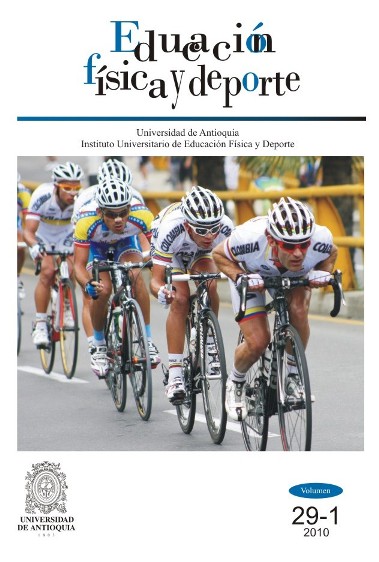Cuphill running and multiple jump exercises for power training in basketball
DOI:
https://doi.org/10.17533/udea.efyd.7163Keywords:
plyometrics, running uphill, power, basketballAbstract
Running uphill as a training method was compared to multiple jumps to improve jumping power in young male basketball players. We carried out a randomized comparative study with 20 male players (23 ± 2,2 years and 182 ± 9 cm) who were randomly assigned to tbe plyometric (n= 10) or running uphill (n= 10) training groups. Jumping ability was determinate through field test (standing long jump, vertical jump, vertical jump with step, and Abalakow´s tests) before training and after 8/12 week post-training. Standing long jump results were significantly higher in the group practicing running uphill compared to plyometrics after 8/12 weeks of training (p=0,09 and p=0,03, respectively). Moreover, vertical jump results were also significantly higher after 12 weeks (p=0.0722). These findings show that running uphill is at least as effective, and even better than the multiple jumps training method for improving explosive strength in young male basketball players.
Downloads
References
1. Biewener, A. A., Farley, C. T., Roberts, T. J., & Temaner, M. (2004). Muscle mechanical advantage of human walking and running: implications for energy cost. J Appl Physiol, 97(6), 2266-2274.
2. Bosco C, Luhtanen P, & Komi PV. (1983). A simple method for measurement of mechanical power in jumping. Eur J Appl Physiol, 50: 273-282.
3. Costill DL, Jansson E, Gollnick PD, & Saltin B. (1974). Glycogen utilization in leg muscles in men during level and uphill running. Acta Phyiol Scand 91: 475-481. 1974.
4. Crisafulli A, Mellis F, Tocco F, Laconi P, Lai C, & Concu A. (2002). External mechanical work versus oxidative energy comsumption ratio during a basketball field test. J Sports Med Phys Fit; 42: 409-417.).
5. Hoffman JR, Tenenbaum CM, Maresh CM, & Kraemer WJ. (1996). Relationship between athletic performance tests and playing time in elite collage basketball players. J Strength Cons Res; 10: 67-71.
6. Grantham N. (2002). Plyometrics in the pool: New research suggests that athletes can boost muscle strength and power with less risk of injury by exercising in water. Sports Inj. Bull. (London) 20: 8-10.
7. Latin RW, Berk K, & Baechle T. (1994). Physical and performance characteristics of NCAA division I male basketball players. J Strenght Cond Res; 8: 214-218.
8. Malisoux L, Francaux M, Nielens H, & Theisen D. (2006). Stretch-shortening cycle exercises: an effective training paradigm to enhance power output of human single muscle fibers. J Appl Physiol; 100: 771-779.
9. Markovic G. (2007). Does plyometric training improves vertical jump heigh?: A meta-analytical review. Br J Sports Med, 41: 349-355.
10. Milgrom C, Finestone A, Levi Y, Simkin A, Ekenman I, Mendelson S, y otros. (2000). Do high impact exercises produce higher tibial strains than running. Br J Sports Med; 34: 195-199.
11. Nicol C, Komi PV, Horita T, Kryolainen H, & Takala TE. (1996). Reduced stretch-reflex sensitivity after exhausting stretch-cycle exercise. Eur J Appl Physiol Occup Physiol; 72: 401-409.
12. Nosaka K, & Kuramata T. (1991). Muscle soreness and serum enzyme activity following consecutive drop jumps. J. Sports Sci, 9: 213-219.
13. Ostojic SM, Mazic S, & Dikic N. (2006). Profiling in basketball: Physical and physiological characteristics of elite players. J Strength Cond Res; 20: 740-744.
14. Roberts TJ, & Belliveau RA. (2005). Sources of mechanical power for uphill running in humans. J. Exp. Biol. 208: 1963-1970.
15. Sloniger MA, Kureton KJ, Prior BM, & Evans EM. (1997). Anaerobic capacity and muscle activation during horizontal and uphill running. J Appl Physiol 83: 262-269.
16. N Apostolidis, G P Nassis, T Bolatoglou, & N D Geladas. (2004). Physiological and technical characteristics of elite young basketball players. Journal of Sports Medicine and Physical Fitness, 44(2), 157-63. Retrieved September 27, 2009, from ProQuest Medical Library. (Document ID: 677974741).











